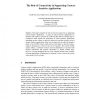Free Online Productivity Tools
i2Speak
i2Symbol
i2OCR
iTex2Img
iWeb2Print
iWeb2Shot
i2Type
iPdf2Split
iPdf2Merge
i2Bopomofo
i2Arabic
i2Style
i2Image
i2PDF
iLatex2Rtf
Sci2ools
HUC
1999
Springer
1999
Springer
The Role of Connectivity in Supporting Context-Sensitive Applications
This paper considers the role of network connectivity in supporting context-sensitive applications. A range of context-sensitive applications are analysed with respect to connectivity. Following this analysis a design space is constructed which enables the positioning of context-sensitive applications depending on their reliance on network connectivity and their reliance on local storage. Further consideration of the role of connectivity is achieved through a study of the GUIDE system which has been developed to provide contextsensitive information to visitors to the city of Lancaster. The current GUIDE system utilises a cell-based wireless network infrastructure to provide both location information and dynamic information to mobile GUIDE units. However, coverage throughout the city is not complete and this raises a number of design implications, including how to maintain a visitor’s trust in the system when outside of cell coverage.
Cell-based Wireless Network | Context-sensitive Applications | HUC 1999 | Human Computer Interaction | Network Connectivity |
| Added | 04 Aug 2010 |
| Updated | 04 Aug 2010 |
| Type | Conference |
| Year | 1999 |
| Where | HUC |
| Authors | Keith Cheverst, Nigel Davies, Keith Mitchell, Adrian Friday |
Comments (0)

